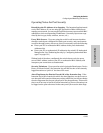
6-135
Configuring the Switch
Class of Service (CoS): Managing Bandwidth More Effectively
Configuring the Switch
No Override. By default, the IP ToS, Protocol, and VLAN ID criteria auto-
matically list each of their options with
No override for priority. This means that
if you do not configure a priority for a specific option, CoS does not prioritize
packets to which that option applies. For example, if you do not specify a
priority for the IP protocol, then the IP protocol will not be a criteria for setting
a CoS priority. In this case, the packets will be handled as described above.
How To Configure CoS
You can use CoS regardless of whether your network has tagged VLANs. As
described earlier (under “Basic Operation” on page 6-132):
■ Using CoS in a tagged VLAN environment controls both of the following:
• Outbound port queue: To which queue (high or normal) a packet
will be sent
• Outbound 802.1p priority: Enters a new 802.1p priority setting in
an outbound packet or retains the packet’s existing 802.1p setting.
This enables the packet to carry an 802.1p priority to the next down-
stream device.
■ Using CoS without a tagged VLAN environment affects only the outbound
port queue to which a packet is sent. (That is, it prioritizes traffic flow
within the switch.) However, without a tagged VLAN environment, an
outbound packet cannot carry an 802.1p priority setting to a downstream
device.
To configure CoS, use this procedure:
1. Determine the CoS policy you want to implement. This includes analyzing
the types of traffic flowing through your network and identifying one or
more traffic types to prioritize. In order of precedence, these are:
a. Device Priority—destination or source IP address (Note that destina-
tion has precedence over source. See Table 6-7.)
b. IP Type of Service
c. Protocol Priority
d. VLAN Priority (requires at least one tagged VLAN on the network)
e. Incoming 802.1p Priority (requires at least one tagged VLAN on the
network)
For more on how CoS operates with the above traffic types, see Table 6-
7. Priority Criteria and Precedence on page 6-134.)
2. If you want 802.1p priority settings to be included in outbound packets,
ensure that tagged VLANs are configured on the appropriate links. (See
“Supporting CoS with an 802.1Q Tagged VLAN Environment” on 6-151.)


















